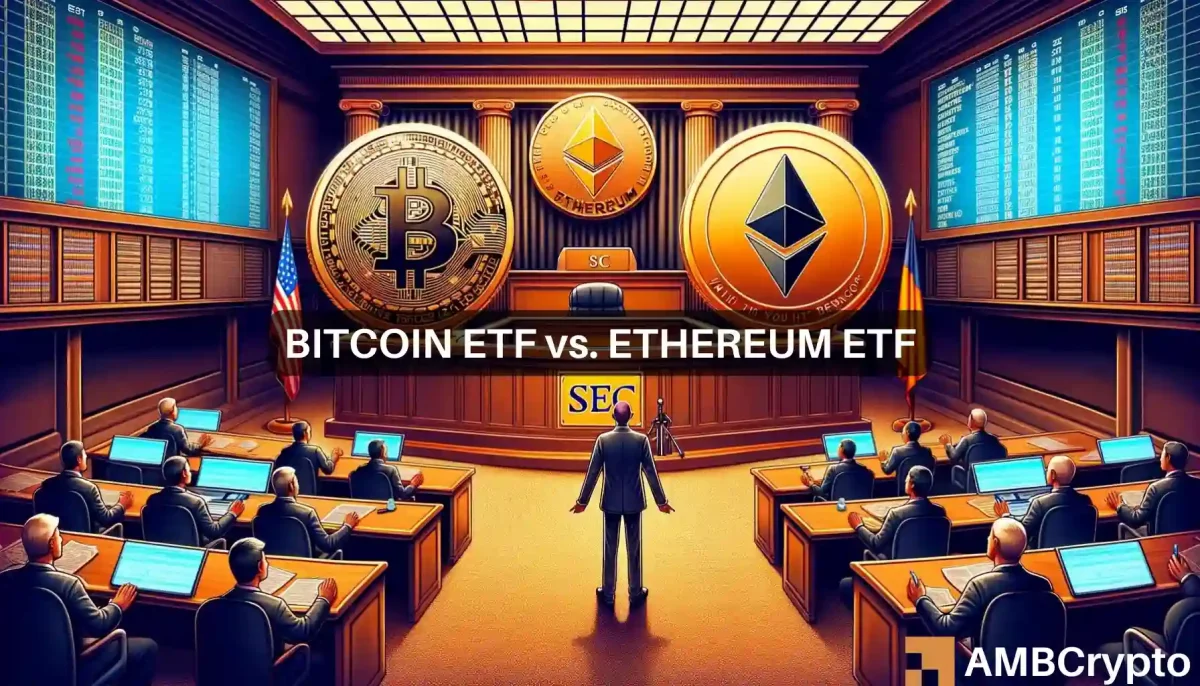eth and bitcoin etf Exploring Cryptocurrency Investments
In the rapidly evolving world of finance, eth and bitcoin etf present exciting opportunities for investors looking to diversify their portfolios. These exchange-traded funds not only offer a way to gain exposure to leading cryptocurrencies but also simplify the investment process, making them accessible to a wider audience. With both Bitcoin and Ethereum ETFs gaining traction, understanding their mechanics and market implications is essential for today’s savvy investor.
The landscape of ETFs has transformed how individuals and institutions alike approach investing, allowing for a more strategic entry into the volatile cryptocurrency market. By comparing Bitcoin and Ethereum ETFs, we can better grasp their unique characteristics and performance metrics, guiding us in making informed investment decisions.
Introduction to ETFs

Exchange-Traded Funds, or ETFs, have emerged as a popular investment vehicle in the financial markets, allowing investors to gain exposure to a diverse range of assets with ease. An ETF is essentially a collection of securities that track an underlying index, commodity, or a basket of assets. The primary purpose of ETFs is to provide investors with a means to diversify their portfolios while enjoying the liquidity of trading on an exchange, similar to individual stocks.ETFs differ from mutual funds in several key aspects.
While mutual funds are actively managed and can only be traded at the end of the trading day at their net asset value (NAV), ETFs are passively managed and can be bought and sold throughout the trading day at market prices. Unlike individual stocks, which represent ownership in a single company, ETFs offer a way to invest in a broader market segment or sector, reducing the risk associated with investing in a single security.
The benefits of investing in ETFs include lower expense ratios, tax efficiency, and greater flexibility in trading.
Overview of Bitcoin ETFs

Bitcoin ETFs have gained significant attention as they allow investors to gain exposure to Bitcoin without having to hold the cryptocurrency directly. These funds function by tracking the price of Bitcoin, providing a convenient way for investors to participate in the cryptocurrency market. Bitcoin ETFs can either hold physical Bitcoin or invest in Bitcoin futures contracts, depending on their structure.There are different types of Bitcoin ETFs available in the market, including those that invest directly in Bitcoin (physical Bitcoin ETFs) and those that focus on Bitcoin futures contracts.
Notable examples of Bitcoin ETFs include the ProShares Bitcoin Strategy ETF and the Valkyrie Bitcoin Strategy ETF, both of which have shown varying levels of performance in response to the market’s volatility. Tracking metrics such as total assets under management and performance relative to Bitcoin’s price can provide insight into these ETFs’ success.
Overview of Ethereum (ETH) ETFs
Ethereum ETFs are similar to Bitcoin ETFs but focus on the second-largest cryptocurrency by market capitalization, Ethereum (ETH). These ETFs typically hold Ethereum tokens or invest in futures contracts related to the cryptocurrency. The operational structure of Ethereum ETFs can be likened to that of Bitcoin ETFs, serving as a conduit for traditional investors to access Ethereum exposure without managing wallets or private keys.When comparing Ethereum ETFs to Bitcoin ETFs, several differences emerge.
For instance, Ethereum’s unique utility and capabilities, such as smart contracts and decentralized applications, may present different investment cases compared to Bitcoin, which is often viewed as digital gold. The potential advantages of investing in Ethereum ETFs include exposure to the growing DeFi ecosystem and NFT market, which are primarily built on the Ethereum blockchain.
Regulatory Landscape
The regulatory landscape for ETFs varies across different regions and is overseen by various regulatory bodies. In the United States, the Securities and Exchange Commission (SEC) is responsible for overseeing ETF applications and ensuring compliance with securities laws. Other countries have their regulatory bodies, which may have differing standards and requirements for ETF approval.Recent regulatory changes have significantly impacted the approval and launch of Bitcoin and Ethereum ETFs.
As regulators become more familiar with cryptocurrencies, there is a growing trend towards the acceptance of these investment vehicles. For example, the approval of Bitcoin futures ETFs marked a pivotal moment, demonstrating a regulatory shift towards acknowledging the legitimacy of cryptocurrencies within traditional financial markets.
Market Performance Comparison
To understand the performance of Bitcoin and Ethereum ETFs, it is essential to analyze their historical performance. Below is a comparison table that details key performance metrics:
| ETF Name | Type | 1-Year Performance | Assets Under Management (AUM) |
|---|---|---|---|
| ProShares Bitcoin Strategy ETF | Futures | +80% | $1 billion |
| Valkyrie Bitcoin Strategy ETF | Futures | +75% | $700 million |
| Grayscale Ethereum Trust | Trust | +150% | $5 billion |
Market trends and volatility are critical factors to consider when analyzing the performance of these ETFs. Bitcoin and Ethereum have historically experienced significant price fluctuations, influenced by factors such as regulatory news, technological advancements, and macroeconomic conditions. Understanding these dynamics can help investors make informed decisions regarding their ETF investments.
Investor Sentiment and Adoption
Investor sentiment towards Bitcoin and Ethereum ETFs has evolved significantly. Initially met with skepticism, these products have gained traction among both institutional and retail investors. The entry of institutional players has legitimized the cryptocurrency market, driving increased adoption of ETFs as an investment vehicle.Institutional investment has played a pivotal role in shaping the adoption of Bitcoin and Ethereum ETFs. Major financial institutions and hedge funds have started allocating portions of their portfolios to these ETFs, recognizing the potential for growth in the digital asset space.
Meanwhile, retail investor interest continues to rise, fueled by increased awareness and accessibility of cryptocurrency investment options.
Risks and Considerations
Despite the potential rewards, investing in Bitcoin and Ethereum ETFs carries inherent risks. Key risks include market volatility, regulatory changes, and the underlying asset’s performance. The cryptocurrency market is known for its rapid price movements, which can significantly impact ETF valuations.Market volatility can lead to sudden price drops, affecting the value of ETFs and the underlying assets they track. Investors should remain aware of these risks and consider strategies to mitigate them, such as diversifying their ETF portfolios or employing risk management techniques to protect their investments.
Future Outlook
The future of Bitcoin and Ethereum ETFs appears promising as trends continue to evolve within the cryptocurrency market. Factors such as increasing institutional interest, advancements in blockchain technology, and broader acceptance of cryptocurrencies in traditional finance are likely to influence the growth of these ETFs.Emerging technologies and innovations, including decentralized finance (DeFi) and non-fungible tokens (NFTs), may create new opportunities for ETFs in the cryptocurrency space.
As the market matures, predictions suggest that cryptocurrency ETFs could experience significant growth, driven by increased mainstream adoption and the development of more sophisticated financial products.
Conclusion

As we conclude our exploration of eth and bitcoin etf, it’s clear that these investment vehicles are changing the game for cryptocurrency enthusiasts. With the ongoing regulatory developments and market performance trends, both Bitcoin and Ethereum ETFs represent not just a trend but a significant evolution in how we invest in digital assets. Staying informed and adaptable will be key for investors looking to navigate this exciting landscape.
Question Bank
What is an ETF?
An ETF, or exchange-traded fund, is an investment fund that is traded on stock exchanges, similar to stocks. It holds assets such as stocks, commodities, or currencies and generally operates with an arbitrage mechanism designed to keep trading close to its net asset value.
Are Bitcoin and Ethereum ETFs safe investments?
While ETFs can provide a safer way to invest in cryptocurrencies compared to buying them directly, they still come with risks due to market volatility. Investors should conduct thorough research and consider their risk tolerance.
Can I hold Bitcoin and Ethereum ETFs in a retirement account?
Yes, many retirement accounts allow the inclusion of ETFs, including Bitcoin and Ethereum ETFs, providing a way to invest in cryptocurrencies within a tax-advantaged account.
What’s the difference between a physical and a futures Bitcoin ETF?
A physical Bitcoin ETF holds actual Bitcoin as its underlying asset, while a futures ETF contracts rights to buy or sell Bitcoin at a future date, which may lead to different performance outcomes.
What factors influence the performance of these ETFs?
Performance can be influenced by various factors including market demand for cryptocurrencies, regulatory news, technological advancements, and overall market sentiment regarding digital assets.



